Menus
- The super sports mega test part 2: racetrack
- Super athlete racetrack test: part 2
- Conclusion
- Aprilia RSV4 Factory APRC SE
- BMW S 1000 RR
- Ducati 1198 SP
- Honda Fireblade
- Kawasaki ZX-10R
- KTM 1190 RC8 R.
- MV Agusta F4
- Suzuki GSX-R 1000
- Yamaha YZF-R1
- Lap times
- The race course
- Data recording
- Tire to test
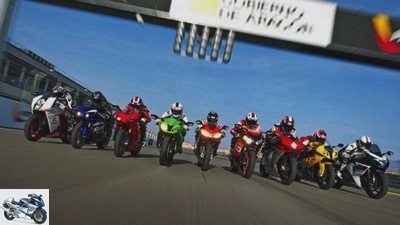
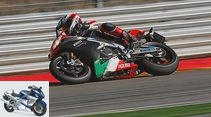
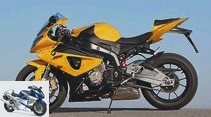
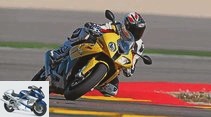
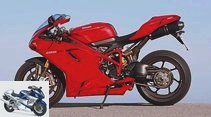
82 photos
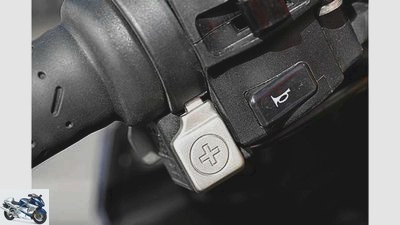
Arts
1/82
Easy to use traction control of the Aprilia.
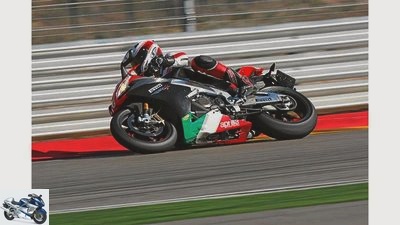
Arts
2/82
A thoroughbred racing file with incredible handling.
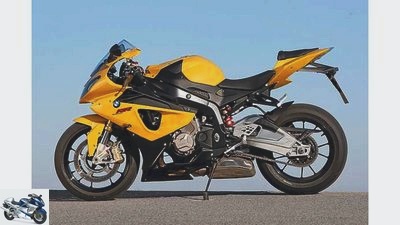
Arts
3/82
BMW S 1000 RR.
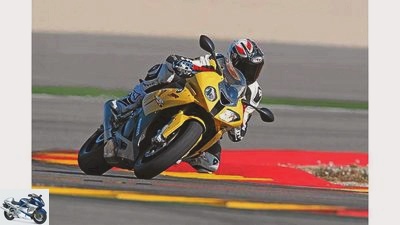
Arts
4/82
The BMW S 1000 RR is equipped with spring elements that master the balancing act between acceptable comfort and sportiness.
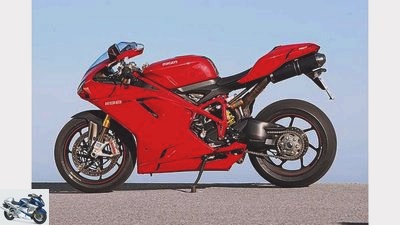
Arts
5/82
Ducati 1198 SP.

Arts
6/82
Thanks to the softer spring, the Ducati has a slightly better balance.

Arts
7/82
Kawasaki ZX-10R.
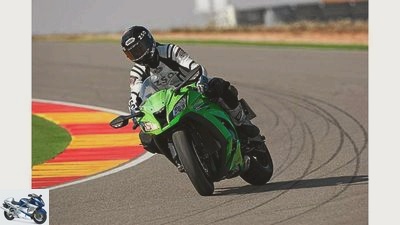
Arts
8/82
The ZX-10R delights with first-class braking stability.
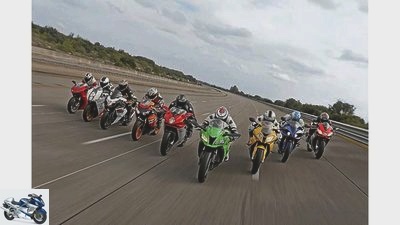
Arts
9/82
In line and speed.
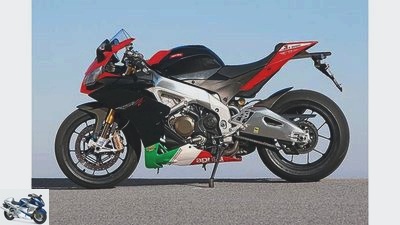
Arts
10/82
Aprilia RSV4.
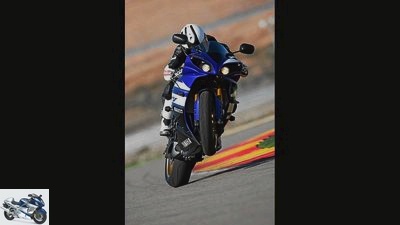
Arts
11/82
The four-cylinder of the Yamaha YZF-R1 was the first to break into the speed range of the 600s.
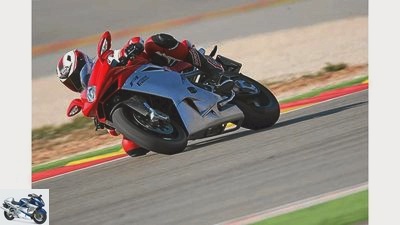
Arts
12/82
The MV Agusta F4 is a feast for the eyes in terms of workmanship.
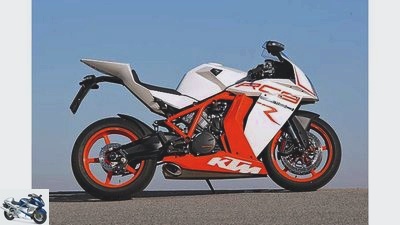
Arts
13/82
KTM 1190 RC8 R..
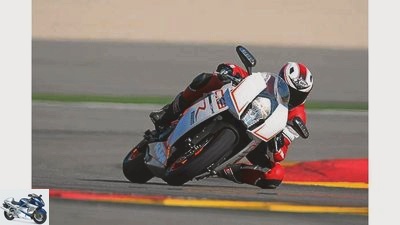
Arts
14/82
The KTM 1190 RC8 R is one of the handiest machines in the field.
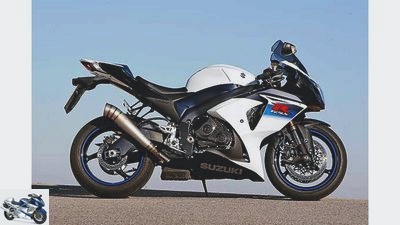
Arts
15/82
Suzuki GSX-R 1000.
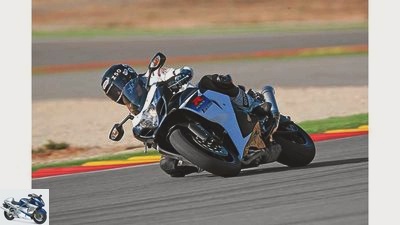
Arts
16/82
Yoshimura exhausts and high windshield only adorn the special model of the Suzuki GSX-R 1000.
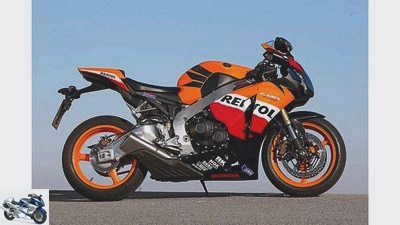
Arts
17/82
Honda Fireblade.
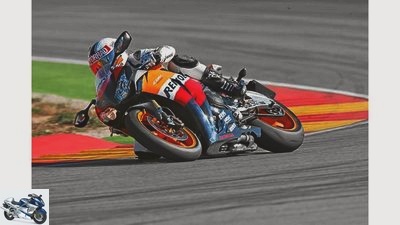
Arts
18/82
Its balance and powerful pulling power are the strengths of the Honda Fireblade.
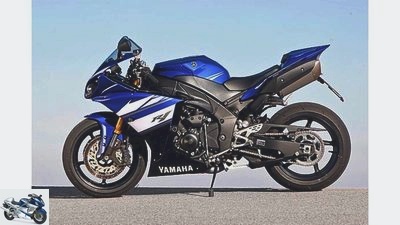
Arts
19/82
Yamaha YZF-R1.
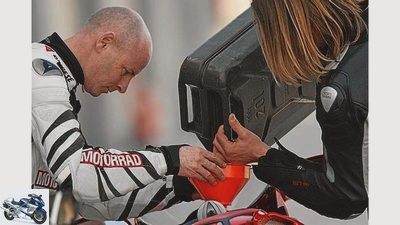
Arts
20/82
Typical: Everyone wants to drive, nobody refuel, that is easily neglected.
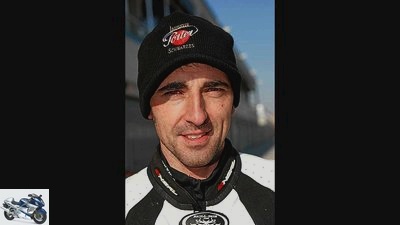
Arts
21/82
Tester: Christian Kellner (MOTORRAD).
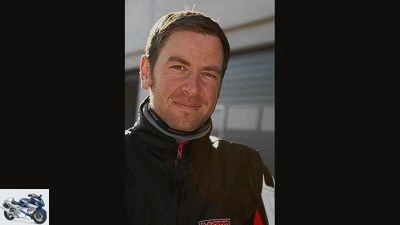
Arts
22/82
Tester: Aurelien Ranea.
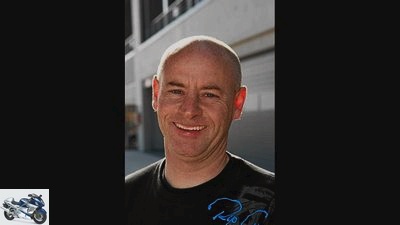
Arts
23/82
Tester: Karsten Schwers (MOTORRAD).
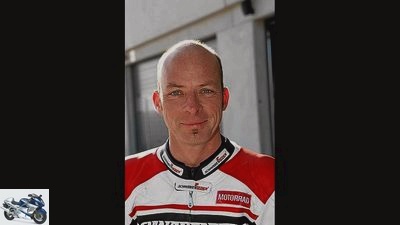
Arts
24/82
Tester: Andreas Bildl (MOTORCYCLE).
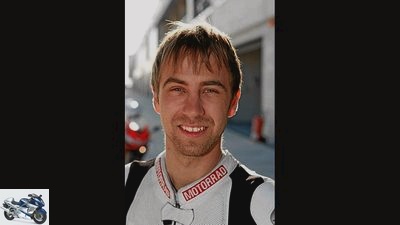
Arts
25/82
Tester: Freddy Papunen.
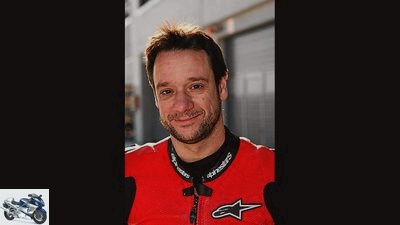
Arts
26/82
Tester: Oscar Marin-Pena.
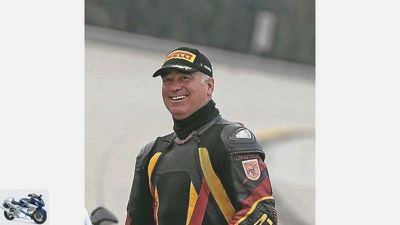
Arts
27/82
Interview: Salvatore Pennisi. Holder of 23 world speed records.
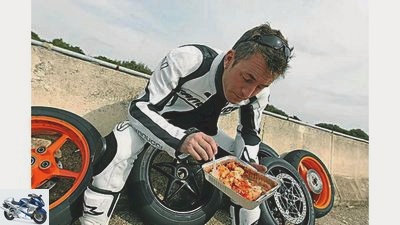
Arts
28/82
A break is a must!
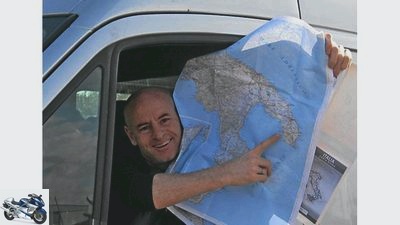
Arts
29/82
You shouldn’t lose your bearings.
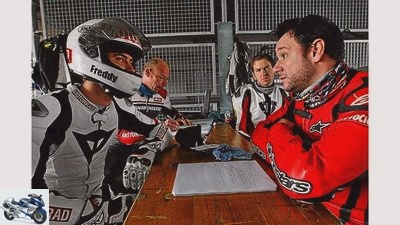
Arts
30/82
Discuss, note, ponder.
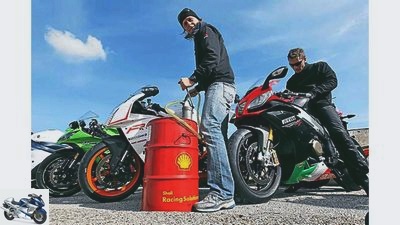
Arts
31/82
All measured values and refueling are meticulously documented.
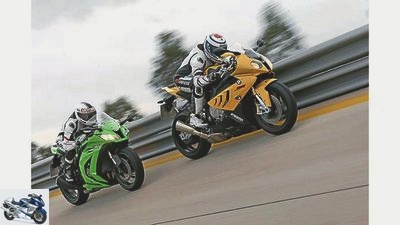
Arts
32/82
The tension at 300 km / h is great!
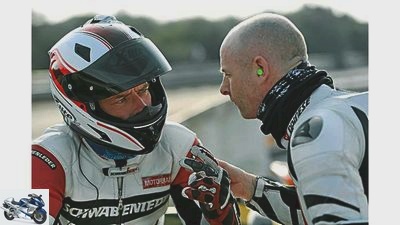
Arts
33/82
Take a break! But only briefly, because the time on the route is limited.
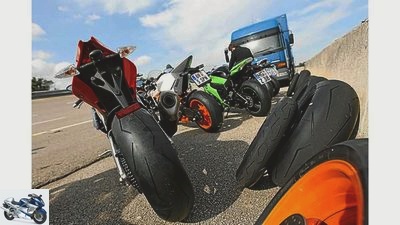
Arts
34/82
Look like production tires, but aren’t: special high-speed rubbers with a harder, more resistant rubber compound.
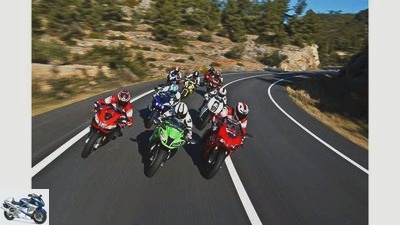
Arts
35/82
They cannot reach their full potential on the country road.
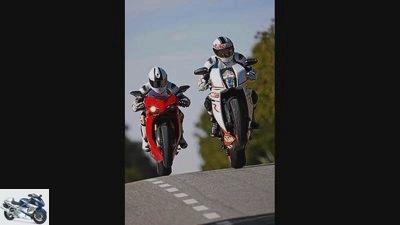
Arts
36/82
The V2 alternatives.
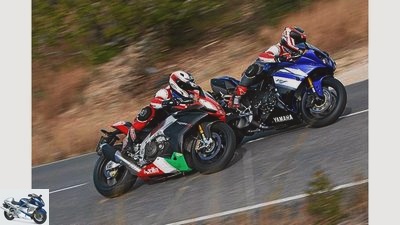
Arts
37/82
Alternative concepts.

Arts
38/82
Can the Kawasaki ZX-10R make the race?
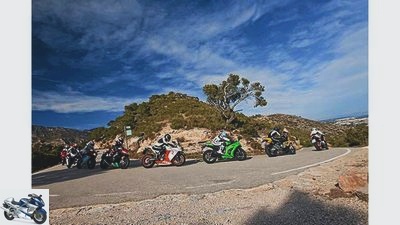
Arts
39/82
Who is the king on the highway?
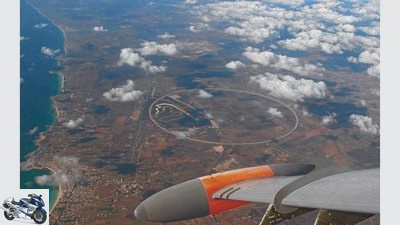
Arts
40/82
Looks like a huge roundabout.
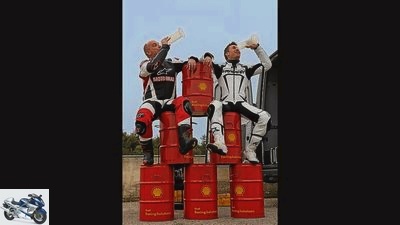
Arts
41/82
Not only the motorcycles are thirsty.
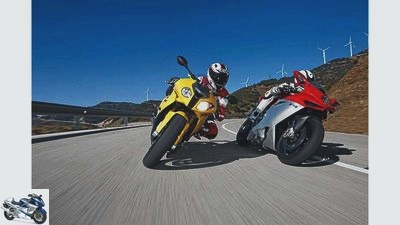
Arts
42/82
Europe’s row four.
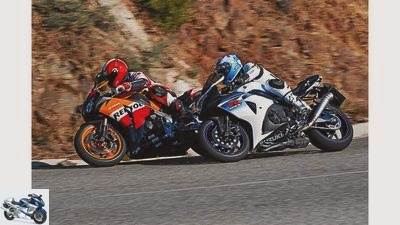
Arts
43/82
Japan’s traditionalists.
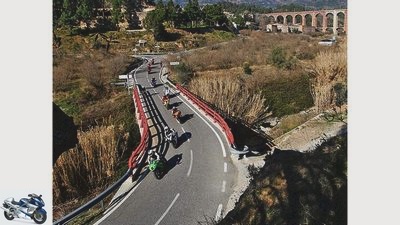
Arts
44/82
You can turn it however you want: Japan was caught off guard last year.
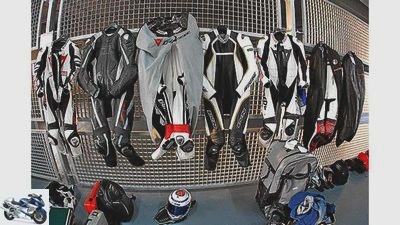
Arts
45/82
When testers drive off the (second) skin, sweaty leather is left behind.
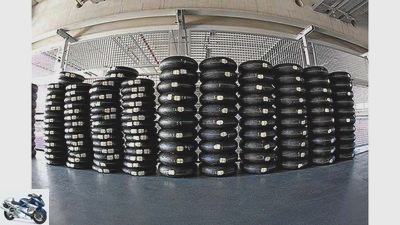
Arts
46/82
Tire to test.
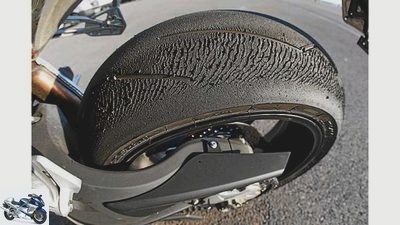
Arts
47/82
Drive until there’s nothing left of the rubber. The material was not spared.
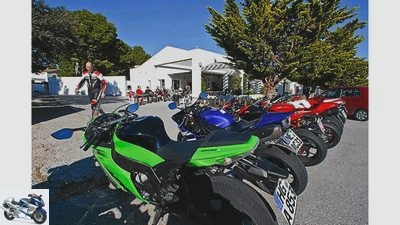
Arts
48/82
Lined up in order.
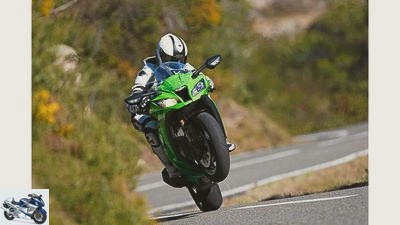
Arts
49/82
The challenger.
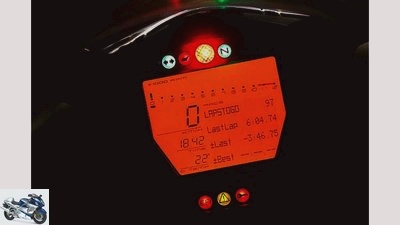
Arts
50/82
Cockpit: KTM.

Arts
51/82
Cockpit: Kawasaki.
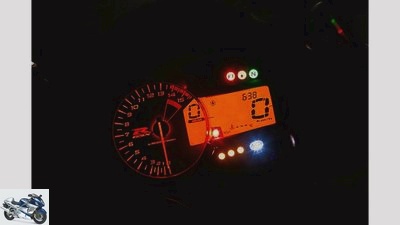
Arts
52/82
Cockpit: Suzuki.
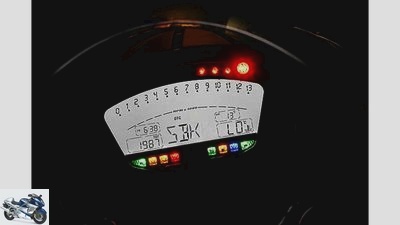
Arts
53/82
Cockpit: Ducati.
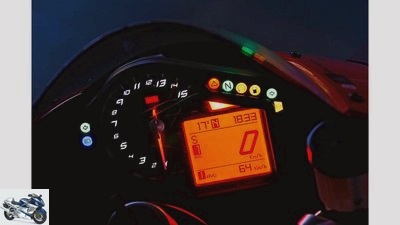
Arts
54/82
Cockpit: Aprilia.
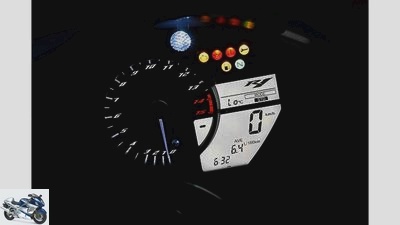
Arts
55/82
Cockpit: Yamaha.
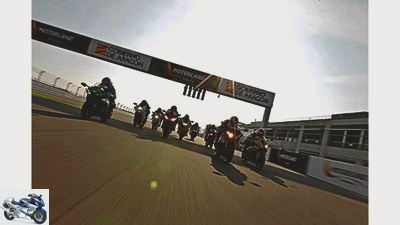
Arts
56/82
The pack chases the wolf.
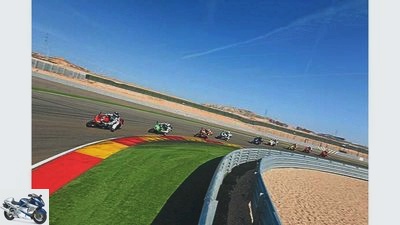
Arts
57/82
Up on the bike and pull on the cable until the winner is found.
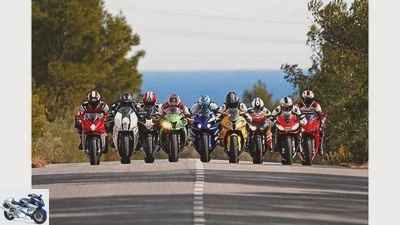
Arts
58/82
Who makes the race?
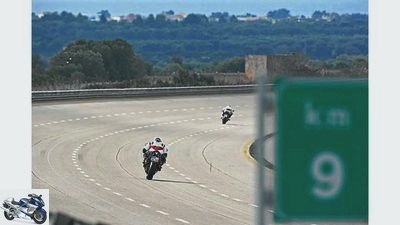
Arts
59/82
Due to their inclination, the upper tracks compensate for transverse forces up to about 240 km / h.
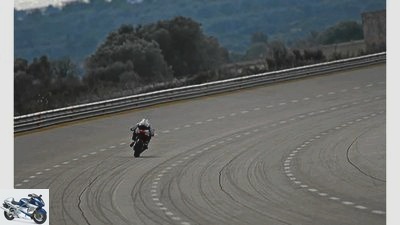
Arts
60/82
The high-speed line mercilessly reveals weaknesses.
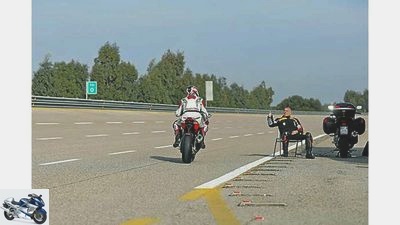
Arts
61/82
Relaxation and concentration before the sightseeing flight.
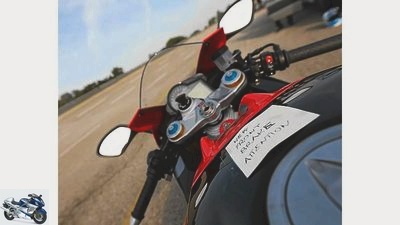
Arts
62/82
To be on the safe side, there is nothing like written reminders.
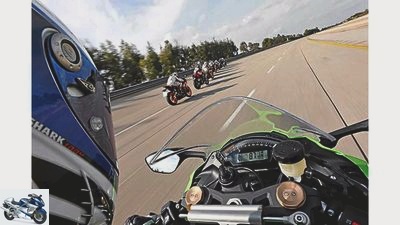
Arts
63/82
Speed regions beyond 250 km / h.
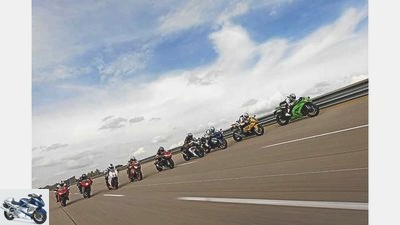
Arts
64/82
The excursion into the realm of extremes.
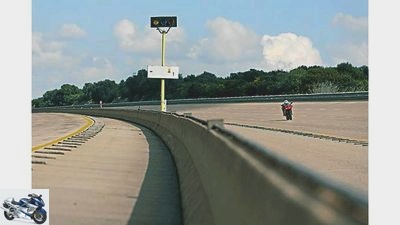
Arts
65/82
Keeping your feet on the ground at this speed – and beyond.
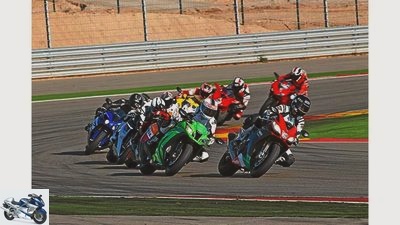
Arts
66/82
Aprilia and Kawasaki are not (yet) enough to jump to the top.
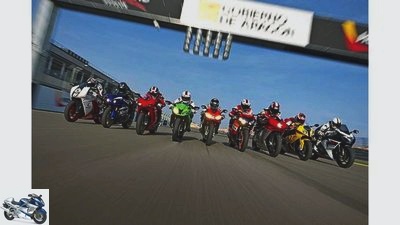
Arts
67/82
In Motorland Aragón, excellence alone does not win a flower pot.
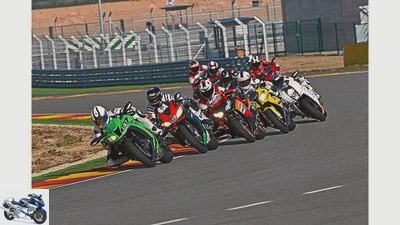
Arts
68/82
This is where the bikes feel most comfortable – on the racetrack.
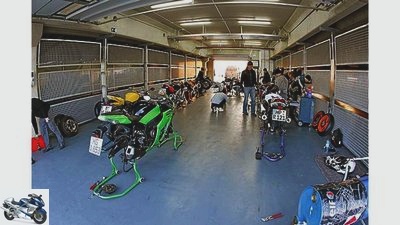
Arts
69/82
Tire change.
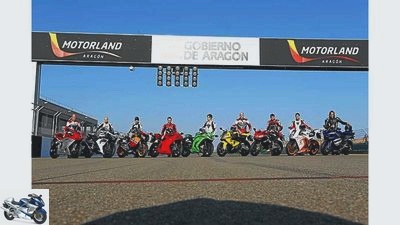
Arts
70/82
Motorcycles with riders – standing up for a change.
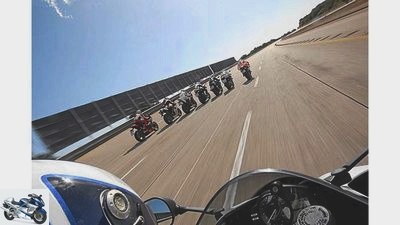
Arts
71/82
The high-speed circuit is about extremes.
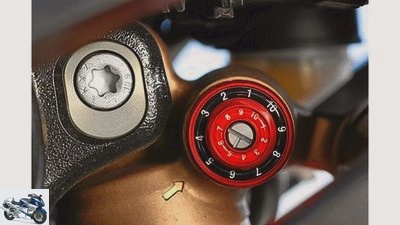
Arts
72/82
BMW S 1000 RR – equipped with spring elements that master the balancing act between acceptable comfort and sportiness.
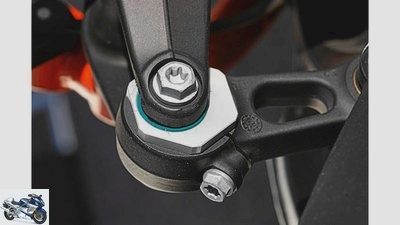
Arts
73/82
The KTM 1190 RC8 R has many intelligent solutions, such as the rear height that can be quickly adjusted with the tool kit.
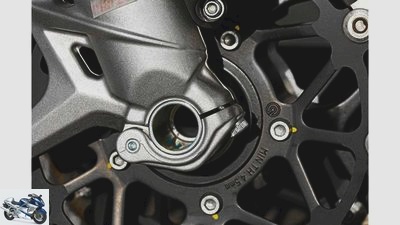
Arts
74/82
The MV Agusta F4 has quick-release fasteners for the front wheel.
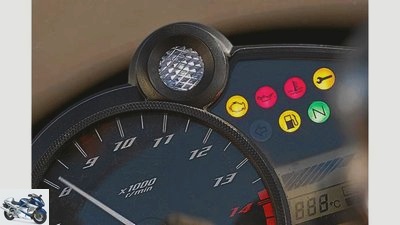
Arts
75/82
The Yamaha YZF-R1 has a bright, optimally placed shift light.
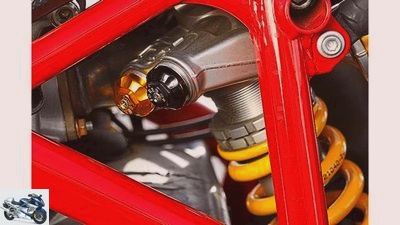
Arts
76/82
The TTX shock absorber from the Ducati 1198 SP from the 1198 R is equipped with a softer spring and helps the Duc to achieve a slightly better balance.
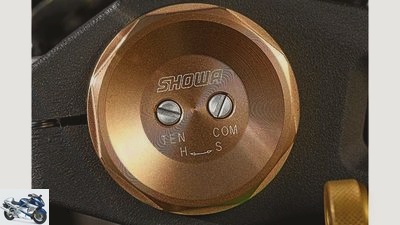
Arts
77/82
The impeccable big piston fork of the Kawasaki ZX-10R only lacks some feedback when it comes to the limit.
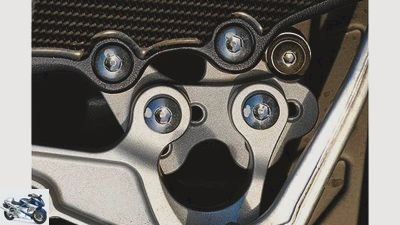
Arts
78/82
The notches on the GSX-R 1000 are adjustable in three positions.
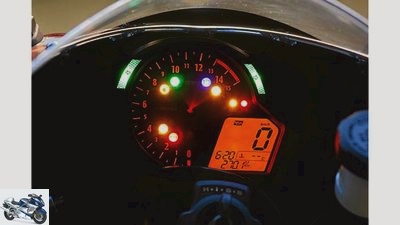
Arts
79/82
Cockpit: Honda.
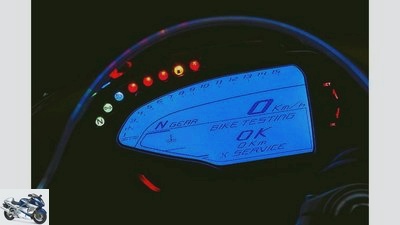
Arts
80/82
Cockpit: MV Agusta.
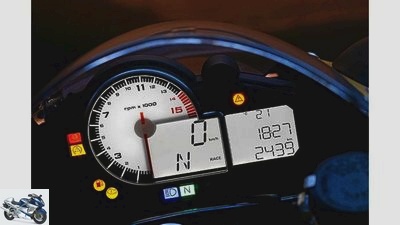
Arts
81/82
Cockpit: BMW.
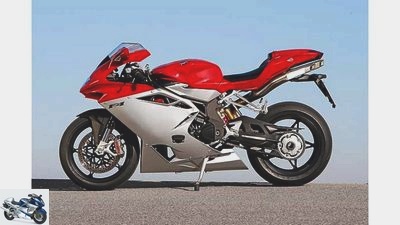
Arts
82/82
MV Agusta F4.
2011 MOTORCYCLE super athlete test
The super sports mega test part 2: racetrack
In its debut year, the BMW S 1000 RR confidently took the lead in the superbike pack. But Aprilia and Kawasaki push forward from the pack. KTM and Ducati have also upgraded. The starting positions have been taken, the clutches at the grinding point, the starting lights go out. The hunt is on.
From MOTORRAD 6/2011
Part 1: Country Road
W.he last year the BMW achieved a stage win in the first part, albeit very close, because the Kawasaki are almost level on points.
Buy complete article
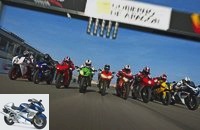
2011 MOTORCYCLE super athlete test
The super sports mega test part 2: racetrack
The hardest thing for last: The high-speed circuit is about extremes. And about the stability of the technology. Only then is the winner determined.
The past year has been tough as hell. For the assembled superbike competition. And somehow also for the testers. Because whenever the BMW S 1000 RR competed, it seemed like no match. But the competition was not idle.
KTM has equipped the RC8 R with more flywheel mass, dual ignition and modified suspension setup. Aprilia redesigned the combustion chambers as well as the cooling and lubrication circuit and gear graduations of the RSV 4. For this purpose, they armed them to the teeth with electronic helpers from launch control to automatic gear change to traction control.
As the first of the Japanese manufacturers, Kawasaki was tired of being washed away by BMW and sends a radically revised, 200 hp ZX-10R into the race to break the hegemony of BMW. On the demanding GP circuit of the Motorland Aragón it should be shown whether and who can take the BMW from the throne. Power is immensely important here, but not everything. Without quick handling, a lot of feeling and confidence in the front wheel, nothing works on this route.
Forget about comfort, range, luggage storage. The top athletes are finally stripping the shackles of the country road and fighting for tenths.
But on the morning of this test day, not a single wheel is turning, not a single engine barking through the empty pit lane. The freezing temperatures of the Siberian cold night still have the route firmly under control. Even the wonderfully sticky Pirelli Supercorsa SC2, which warm under the electric blankets on all test machines, would not be able to provide reliable grip. And dragging a crumpled bike out of the gravel with frostbite on their fingers, none of the pilots want to do that anyway. A six-strong international team of testers is ready to put the new ones to the test, four of whom will be chasing times.
Last year’s IDM Superbiker and ex-Supersport World Championship driver Christian Kellner, in short "trowel", is supposed to squeeze the last tenths out of the machines together with the Swedish superbike champion Freddy Papunen. In addition, as an ambitious amateur racer and hobby pilot, the author will go on a hunt for times to find out what potential the bikes can develop in differently skilled hands. The average lap time is then calculated from the fastest laps. But that’s not all that counts, it’s about the overall performance.
After an hour or two, the sun finally warmed the air and asphalt. Two and four cylinders come to life, the air in the pits vibrates under their gas, electric blankets are unwound, the pits light is green, and it begins.
The Italian beauty MV Agusta F4 was the first to hit the stage. It is already somewhat overshadowed by the flashy, superlative competition. It is clear that there was criticism for the somewhat old-fashioned, elongated push-up sitting position on the country road. But as the pace increases, it makes sense, and at the latest when you smash the MV into the brutally fast left-hand bend before the start-finish, at the latest, you are grateful for the pressure you put on the front wheel and the fantastic feedback you get . You literally grow together with the motorcycle to form a unit. Thanks to the tight, yet sensitive spring elements, the MV lies as if dowelled. And on the following straight at the latest, the MV engine shows that it is not only in the top league in terms of sound. The four-cylinder equipped with radially arranged valves and length-adjustable intake funnels may be a little hard on the gas, but sends 181 hp into the transmission with robust trumpets. Enough for the third highest top speed at 278 km / h at the end of the back straight. This is where their next trump card stands out: excellent brakes and, above all, fantastic braking stability. Even if the next lower gear in the somewhat hard but precise gear is pressed in at an angle, the slip clutch keeps disturbing load peaks away from the rear wheel.
Typical: Everyone wants to drive, nobody refuel, that is easily neglected.
In this way, the MV impressively demonstrates that it is more than a pretty piece of mechanical engineering, namely a damn fixed racetrack motorcycle that actually only lacks more agile handling for absolute top lap times. Which slows the hobby racer down much more than the other three pilots. Things like an easy-to-read tachometer and a display with a large gear indicator and a concise shift light, on the other hand, would make it easier for everyone to chase times.
The change from the MV to the Suzuki GSX-R 1000 almost feels like taking a seat on a touring athlete. Embedded deeper in the motorcycle, the handlebar stubs higher and significantly narrower, plus the expansive tank and the high windshield that adorns the special edition of the GSX-R. You first think of a relaxed, sporty ride than the merciless time filing.
And on the track, too, the Suzuki initially feels big and heavy. Because of Fit for Fun, not sports-like at all. The sluggish handling and the softly tuned spring elements underline this impression.
But on the other hand there is also this engine. The GSX-R drives have enjoyed an excellent reputation, and not just since the blessed K5. Its soft throttle response and the easily controllable thrust ensure that you use the existing power at the top of the curve and come out of the corners with a lot of momentum.
The gently and precisely flowing gears are also a plus point during the subsequent sprint. However, the engine only offers meager home cooking with its narrow 171 hp. The fact that the Suzuki does not completely lose touch with the top speed values speaks for the good acceleration and the smooth transmission.
Aprilia and Kawasaki are not (yet) enough to jump to the top.
When braking, however, the Suzuki leaves springs. Your stoppers respond bluntly and require temperature. And even then, a firm grip elicits a decent delay. The poor performance on the brakes is then only followed by an average of precise steering due to the soft tuning. And yet you feel comfortable on the Suzuki, it conveys trust. One tester even got a comparison with a sofa. Which is not stressful, but ultimately not really fast either.
After the country road test, the Yamaha YZF-R1 was also in the midfield. Above all, the inline four-cylinder with its unconventional crank pin offset earned applause there with its beguiling, grumpy sound and a full start. He also received a lot of praise on the racetrack. First. Especially the way he pushes the R1 out of tight corners and then turns it up lightly is a pleasure. Likewise the direct, albeit slightly accentuated, throttle response. In addition, the seating position and the cranking of the handlebars appear more harmonious than on the Suzuki. And because the Yamaha can be chased through the corners more docile, feeling good on board the R1 is the order of the day.
But this is about the dance on the last groove. And then the R1 weakens a little. The six-piston stoppers do their job properly, but if the pilot just barely misses the turn-in point, the R1 can only be directed back onto the targeted line with difficulty. "Motorcycle pushes outwards", reads "Ladle" concise comment. In addition, the comfortably coordinated spring elements and the baroque stature at 214 kilograms leave no room for crisp stability in the fast chicanes. "After a few laps, the shock absorber is at the end of the damping", complains Freddy Papunen. And: "The engine is really good. With more power it would be really great." That’s exactly where the rabbit is in the pepper. Because of the promised 182 hp, only a disappointing 168 are at the start of the R1. What the red lantern means on the test bench and which should be the main reason why it is also put on when the time hunted.
At the other end of the timesheet, at the top, the new Kawasaki ZX-10R wants to be at the end of the day. And the signs are good. With 197 hp it is damn close to the strikingly powerful BMW. And the chassis, which is praised for its handiness on the country road, should also score here.
Super athlete racetrack test: part 2
Wild pack. But in Motorland Aragón you don’t win a flower pot with top performance alone, you have to be washed up and down.
The Kawasaki starts like a whirlwind. Inspired by the successful seating position and the narrow tank, you can quickly get rid of all inhibitions. Its precision, the ease with which it meanders through alternating curves, and the engine, which goes off like a prick from 10,000 rpm, literally encourages an aggressive pace. In addition, the first three gears are translated as long as in a real racing gearbox. The second goes up to an incredible 192 km / h. And so it fits from the end of the start-finish straight to the braking of the corkscrew-like downhill chicane at the beginning of section 2 (see race track). Switching is not necessary.
But despite all its handiness and neutrality, the Kawa messes up a little in the tight corners. On the one hand because of their sometimes minimally delayed throttle response after rolling phases. On the other hand, the long gear ratio of the lower gears is a disadvantage when it comes to tight corners in second gear. The punch from the bottom is missing. That costs just as valuable tenths when starting as the lack of an automatic gearshift when sprinting through the gears. But with her tremendous power she makes up for at least part of the time lost on the straights – her top speed values speak volumes. In view of this, your brakes – in this test without ABS – could work more resolutely. Then you could make even better use of the fantastic braking stability.
When firing into the start-finish straight, the traction control, if on the sharpest of its three levels, ensures maximum traction and brilliant acceleration by intervening late. Even if the professional racers want a bit stiffer spring elements – the poorly accessible rebound stage of the shock absorber was almost closed in the end – and the feedback from the big piston fork on the last groove could be better, both professionals and the amateur marked with the Kawa her fastest lap time for the time being. Fake.
But that is subito again in danger. The Aprilia RSV4 APRC SE takes to the track. A motorcycle that is built for one purpose only: fast lap times. And truly, like no other, the Aprilia gives its driver the feeling of sitting on a real racer, of being one. Compact, focused, ready to attack. Whoever got off her and took off their helmet had an ecstatic grin on their face.
Discuss, take notes, ponder – and then get back on the bike and pull the cable until the winner is found.
So filigree, so finely balanced and manageable that it almost steals your senses. In addition, the beguiling roar of the V4. It’s just a lot of fun shooing the RSV4 around the course. The Brembo stoppers act as a buffer stop and quick changes of direction are a feast. In addition to a sophisticated geometry and center of gravity, the spectacular handling also has very mundane reasons: At 5.9 kilograms (including brake discs) it has by far the lightest front wheel. Which creates less stabilizing gyroscopic forces. Something like that inspires the handling enormously. At best, the Ducati (6.1 kg) comes close. The others range between 6.6 (Honda) and 7.2 kilograms (Suzuki).
Its powerful 180 hp can be used perfectly thanks to the eight-stage traction control, which can be easily adjusted from the handlebars and whose Bosch sensors correspond to those of BMW. The V4 pushes grumpily from medium speeds, turns lightly upwards. And thanks to the automatic gearshift, you can do the rest with short, precise gear changes.
But despite the wide 200 mm rear tire, both professional racers complain a little too little grip on the rear wheel. In the end, Freddy Papunen doesn’t come close to his Kawasaki times, but Kelle and the author still clearly set their best times with her.
It’s actually the same as always when you take a seat on the Honda Fireblade. You hook into the command center and, except for the slightly high notches, immediately have the feeling that it fits. You gain confidence and are quick on the spot. Darn quick. With 178 PS on par with Aprilia and MV and thus significantly stronger than Suzuki and Yamaha, plus a good punch from the middle, something is going. And the handling and neutrality of the Honda are still at the top of their class. "With it you drive so playfully into the curves and almost always hit the desired line", Freddy raises his thumb. "A very good, easy to ride motorcycle", Kelle agrees. So easy and uncomplicated that the hobby racer can achieve his best lap time with it. The uncomplicated nature obviously suits him more than mega power or pointed handling. And that for sure, even if ABS, which acts too defensively at high speeds, gives him additional confidence.
Drive until there’s nothing left of the rubber. The material was not spared.
With all other drivers, however, the Honda has to be content with a good midfield position. What is missing to land further ahead? Mainly just a shot of power and a firmer chassis. In addition, she lacks helpful things like automatic gearshift, clearly recognizable shift light, gear indicator or even traction control when chasing times.
The BMW S 1000 RR has all of this. And even more. More power. It is always breathtaking the force with which it gets down to business, the force with which the engine pulls the tachometer needle into the limiter in the upper gears as well. Their traction control is also a safe bet against the newer systems from Kawasaki and Aprilia. One has even in the sharp "Slick"-Modus sometimes the feeling that she might intervene a little later. But on the other hand, it conveys a feeling of security like no other.
In the tricky braking zones, the pilot can rely on the brakes that can be applied magnificently, grabbing like a trap iron, supported by the late-acting ABS. Although the pressure point initially moved a little towards the handlebars, it then remained stable.
Despite the mighty top performance, the BMW driver does not have to do without full thrust from the corners. Thanks to the cleverly selected gear ratio, the BMW is also a force in second-gear corners when starting.
Only the stiff throttle and the sticky gearshift despite the automatic gearshift – sometimes the sixth gear didn’t want to go in – don’t quite fit into the picture. On the other hand, you will get over the fact that the S 1000 RR is only mediocre when it comes to handling, given its stability and accuracy. Because all in all, the BMW is an overall package that is still hard to beat. And so the pros hit by far the fastest laps with it. With which the BMW can calmly look forward to the appearance of the Twins.
Or can the KTM 1190 RC8 R cause a surprise? A respectable 174 hp, full twin thrust from the corners and a chassis that has been praised for its handiness and has benefited from the revision for 2011, one can be curious.
Acoustically, the KTM is at the forefront, roaring across the start-finish straight with impressive roars. In the following meandering curve she is fully in her element, in section 1 she even sets the second-best section time. The balance has benefited from the softer suspension strut. The fact that it is not enough at the best time is mainly due to the short geared gears. This forces to much more frequent shift maneuvers than with the high-revving four-cylinder, which costs time not least because of the hard transmission.
When testers drive off the (second) skin, sweaty leather is left behind.
In no time at all, the KTM whirls through the corkscrew curve and, thanks to the fantastic traction and the great grip feeling, adds a crisp section time in the long left turn that follows. But when braking into the following third sector, the tenths that have just been won go back to normal. The otherwise effective stoppers cannot be perfectly dosed to the point during hard braking maneuvers at high speed, and such deposits also cause unrest in the rear.
When accelerating out of the chicanes, the RC8 R first makes a lot of meters with a powerful acceleration. But on the following straights, the frequent shift work immediately costs time again, and in no time the KTM hammers on the back straight in sixth gear with pithy vibrations in the highest positions, where the more powerful four-cylinder accelerate further in the fifth (see data recording). The deficit in top speed is correspondingly blatant. Seen in this light, the sixth fastest time on average is a remarkable result.
That it is clear to crack for the Ducati 1198 SP. A matter of honor. After all, she has racing genes like no other. The Ohlins TTX shock absorber from the 1198 R, which was no longer built, the automatic gearshift, slip clutch and larger aluminum tank ennoble the previous one "S." to "SP".
On the engine side, everything stayed the same. Which is not a mistake, because the fiery V2 heart has always been the strength of the Ducati. With grim determination, he fires the Ducati out of the second-gear corners so that it barely keeps the front wheel on the ground. And if the pilot pushes the mighty grip on the rear wheel to its limits, the effective, albeit somewhat coarse, traction control prevents creases in the red dress. Although nominally a bit weaker than the KTM, the Twin feels powerful and agile even at high revs.
The spring strut equipped with a somewhat softer spring actually ensures a slightly better balance, which gives it additional stability in her favorite area, the fast, long arches. But the soft fork tuning still interferes with the merciless gasping. There is a lack of stability and confidence in the front wheel. Whether when diving into the corkscrew curve or at the braking point in front of section 3, where at an incline from a good 230 km / h on the brakes you enter a curve that slopes slightly outwards. For quick changes of direction, the Duc still requires the most physical effort. And if the concentrated twin power is unleashed at the apex of the bend, a very sensitive hand is required for the burgeoning movement in the chassis to subside again. Above all, however, the transmission and automatic transmission refused to work together harmoniously. The annoying result: Instead of going into the next gear, the testers repeatedly ended up in an intermediate idle. Despite everything, Freddy Papunen wrestled his fourth fastest time personally, which basically shows the Duc’s potential. But he was the exception. All the others struggled at rather restrained times, which in the end, despite all the fascination that emanates from them, relegated the Ducati to the back third of the field. In the end, it was not able to shake the dominance of the BMW on the race track either. But she can already feel the breath of her pursuers on her neck.
Conclusion
The nine super athletes have finally made it to the home straight.
1st place: BMW S 1000 RR
Oops, that was close, the competition has caught up. But the powerful engine, driving aids and the stable, albeit not particularly agile chassis ensure victory.
2nd place: Aprilia RSV4 Factory
Although without ABS, the handling queen has caught up with the BMW through the facelift. Stable chassis, bombastic brakes, dreamlike precision.
3rd place: Kawasaki ZX-10 R
The new ten is a huge step forward. Not just because of the performance. Above all, the chassis is now among the best in its class. But not the pressure from the middle.
4th place: MV Agusta F4
She is beautiful. And it’s fast. When the rearview mirror, light and comfort are not what count, the MV is too big. Not particularly handy, but with fire and stable like the Ducatis once did.
4th place: Honda Fireblade
The affable, the balanced. With linear power delivery, the Honda is still fast and more sensible than mediocre despite the comfortable chassis.
6th place: KTM 1190 RC8 R
The revision of the chassis and engine was good for the Austrian Donnerbolzen. Nevertheless, there remains a significant performance deficit and the shift foot hardly comes to rest.
6th place: Yamaha YZF-R1
Last year’s third has slipped. What scores in everyday life, their comfortable chassis, is only mediocre on the racetrack. And with the weakest engine is no longer possible.
8th place: Suzuki GSX-R 1000
The GSX-R is getting on in years. Revision is necessary. Neither handling nor braking nor stability set an exclamation point. The only highlight: the powerful engine.
8th place: Ducati 1198 SP
Sure, the balance of the "SP" is opposite to the old one "S." a little better, and it also has the automatic gearshift and traction control. In addition a wonderfully fiery V2. But that is not enough.
MOTORCYCLE racetrack ranking
The BMW engine is the measure of all things, its braking performance is top class, the chassis without any real weaknesses. But adjusted for the ABS, the Aprilia, the secret winner of the racetrack shootout, would be at the top. The Kawasaki makes a strong debut, and immediately joins the Superbike top. These three have – perhaps thanks to their well-functioning traction controls – clearly set themselves apart from the rest of the field, which is led by the surprisingly powerful MV Agusta.
Winner race track classification: BMW S 1000 RR
| Max points | Aprilia | BMW | Ducati | Honda | Kawasaki | Total | 400 | 362 | 366 | 320 | 339 | 349 |
| placement | 2. | 1. | 8th. | 4th. | 3. |
| Max points |
KTM |
MV Agusta |
Suzuki |
Yamaha | Total |
400 | 324 | 339 | 320 | 324 |
| placement |
6th. | 4th. | 8th. | 6th. |
MOTORBIKE intermediate ranking
| Max points | Aprilia | BMW | Ducati | Honda | Kawasaki | Total 1000 points Evaluation (MOTORRAD 06/2011) |
1000 | 671 | 709 | 624 | 690 | 703 |
| Total race track rating | 400 | 362 | 366 | 320 | 339 | 349 | Total intermediate result | 1400 | 1033 | 1075 | 944 | 1029 | 1052 |
| Placement intermediate result | 3. | 1. | 9. | 4th. | 2. |
| Max points |
KTM |
MV Agusta |
Suzuki |
Yamaha |
Total 1000 points Evaluation (MOTORRAD 06/2011) |
1000 | 667 | 629 | 667 | 668 |
| Total race track rating |
400 | 324 | 339 | 320 | 324 | Total intermediate result |
1400 | 991 | 968 | 987 | 992 |
| Placement intermediate result |
6th. | 8th. | 7th. | 5. |
After two parts of the mega test, Aprilia, BMW, Honda and Kawasaki go into the final with the best chances of victory.
Intermediate winner: BMW
archive
The performance diagram of the nine super athletes.
Aprilia RSV4 Factory
A highly emotional engine that may not be in the front row when it comes to peak performance, but which inspires with revving and pulling power.
BMW S 1000 RR
One look at the diagram is worth a thousand words. The fact that the BMW engine also pulls through powerfully deserves all the more respect
Ducati 1198 SP
The relatively low performance does not adequately reflect the impressive driving experience with this twin.
Honda Fireblade
Actually an exemplary curve that just lacks the necessary top performance in this environment. The dent at 4000 rpm is insignificant on the racetrack.
Kawasaki ZX-10R
Very close to the top, but this high-altitude flight is bought with a weak middle.
KTM 1190 RC8 R.
The fat torque catches the eye and makes the KTM the boss at the corner exit. In addition, 174 hp is a real word for a twin.
MV Agusta F4
Strong 181 hp – and yet only the best of the rest. Despite the wavy torque curve, this engine is a lot of fun on the racetrack.
Suzuki GSX-R 1000
The very cultivated, high-torque drive scores on the country road, but has lost ground in terms of performance.
Yamaha YZF-R1
In terms of performance, the disappointing bottom light, despite the fine revving and great sound.
Aprilia RSV4 Factory APRC SE
A thoroughbred racing file with incredible handling, which has become even better and faster thanks to the easy-to-use traction control and automatic gearshift.
| engine | design type | Four cylinder 65 degree V engine |
| injection | Ø 48 mm | coupling | Multi-disc oil bath clutch |
| Bore x stroke | 78.0 x 52.3 mm | Displacement | 1000 cm3 |
| compression | 13.0: 1 | power | 132.4 kW (180 PS) at 12500 rpm |
| Torque | 115 Nm at 10000 rpm | landing gear | frame | Bridge frame made of aluminum |
| fork | Upside-down fork, Ø 43 mm | Brakes v / h | Ø 320/220 mm |
| Assistance systems | Traction control | bikes | 3.50 x 17; 6.00 x 17 |
| tires | 120/70 ZR 17; 200/55 ZR 17 | Tires | Pirelli Diablo Supercorsa SP vo. "C." |
| mass and weight | |
| wheelbase | 1420 mm | Steering head angle | 65.5 degrees |
| trailing | 105 mm | Suspension travel v / h | 120/130 mm |
| Seat height | 840 mm | Weight with a full tank | 205 kg |
| Payload | 201 kg | Tank capacity / reserve | 17 liters |
| Service intervals | 10000 km | Price (without additional costs) | 22,500 euros |
| Price test motorcycle | – |
* Manufacturer information
BMW S 1000 RR
Committed to stability rather than nimble handling and equipped with spring elements that master the balancing act between acceptable comfort and sportiness, goodies such as rear height adjustment are also not missing.
| engine | design type | Four-cylinder in-line engine |
| injection | Ø 48 mm | coupling | Multi-disc oil bath clutch |
| Bore x stroke | 80.0 x 49.7 mm | Displacement | 999 cm3 |
| compression | 13.0: 1 | power | 142.0 kW (193 hp) at 13,000 rpm |
| Torque | 112 Nm at 9750 rpm | landing gear | frame | Bridge frame made of aluminum |
fork
* Manufacturer information
**Incl. ABS and DTC (1220 euros) and automatic gearshift (360 euros)
Ducati 1198 SP
The TTX strut with a softer spring from the 1198 R helps the Duc to achieve a somewhat better balance, but does not prevent the 1198 SP from falling behind despite the fiery V2.
| engine | design type | Two cylinder 90 degree V engine |
| injection | Ø 64 mm | coupling | Multi-disc oil bath clutch |
| Bore x stroke | 106.0 x 67.9 mm | Displacement | 1198 cm3 |
| compression | 12.7: 1 | power | 120.0 kW (163 hp) at 9750 rpm |
| Torque | 131 Nm at 8000 rpm | landing gear | frame | Steel tubular frame |
| fork | Upside-down fork, Ø 43 mm | Brakes v / h | Ø 330/245 mm |
| Assistance systems | Traction control | bikes | 3.50 x 17; 6.00 x 17 |
| tires | 120/70 ZR 17; 190/55 ZR 17 | Tires | Pirelli Supercorsa SP |
| mass and weight | |
| wheelbase | 1430 mm | Steering head angle | 65.5 degrees |
| trailing | 104 mm | Suspension travel v / h | 120/127 mm |
| Seat height | 810 mm | Weight with a full tank | 196 kg |
| Payload | 194 kg | Tank capacity / reserve | 18 liters |
| Service intervals | 12,000 km | Price (without additional costs) | 22,690 euros |
| Price test motorcycle | – |
* Manufacturer information
Honda Fireblade
Their balance and powerful draft are their strengths. But the competition is now ahead in terms of engine performance and driving aids. The very easy to read cockpit is also stingy with additional information.
| engine | design type | Four-cylinder in-line engine |
| injection | Ø 46 mm | coupling | Multi-disc oil bath clutch |
| Bore x stroke | 76.0 x 55.1 mm | Displacement | 1000 cm3 |
| compression | 12.3: 1 | power | 130.7 kW (178 hp) at 12,000 rpm |
| Torque | 112 Nm at 8500 rpm | landing gear | frame | Bridge frame made of aluminum |
| fork | Upside-down fork, Ø 43 mm | Brakes v / h | Ø 320/220 mm |
| Assistance systems | SECTION | bikes | 3.50 x 17; 6.00 x 17 |
| tires | 120/70 ZR 17; 190/50 ZR 17 | Tires | Bridgestone BT015 "F." |
| mass and weight | |
| wheelbase | 1410 mm | Steering head angle | 66.8 degrees |
| trailing | 96 mm | Suspension travel v / h | 120/135 mm |
| Seat height | 830 mm | Weight with a full tank | 209 kg |
| Payload | 170 kg | Tank capacity / reserve | 17.7 liters |
| Service intervals | 6000 km | Price (without additional costs) | 14990 euros |
| Price test motorcycle | 15990 euros ** |
* Manufacturer information
**Incl. ABS (1000 euros)
Kawasaki ZX-10R
The ZX-10R delights with first-class braking stability. The test motorcycle for this comparison did not have ABS. The otherwise flawless Big Piston Fork only lacks some feedback in the border area.
| engine | design type | Four-cylinder in-line engine |
| injection | Ø 47 mm | coupling | Multi-disc oil bath clutch |
| Bore x stroke | 76.0 x 55.0 mm | Displacement | 998 cm3 |
| compression | 13.0: 1 | power | 147.0 kW (200 hp) at 13,000 rpm |
| Torque | 112 Nm at 11500 rpm | landing gear | frame | Bridge frame made of aluminum |
| fork | Upside-down fork, Ø 43 mm | Brakes v / h | Ø 310/220 mm |
| Assistance systems | ABS / traction control | bikes | 3.50 x 17; 6.00 x 17 |
| tires | 120/70 ZR 17; 190/55 ZR 17 | Tires | Bridgestone BT016 hi. "CC" |
| mass and weight | |
| wheelbase | 1425 mm | Steering head angle | 65.0 degrees |
| trailing | 107 mm | Suspension travel v / h | 120/125 mm |
| Seat height | 810 mm | Weight with a full tank | 203 kg |
| Payload | 175 kg | Tank capacity / reserve | 17 liters |
| Service intervals | 6000 km | Price (without additional costs) | 15,495 euros |
| Price test motorcycle | 16,495 euros ** |
* Manufacturer information
**Incl. ABS (1000 euros)
KTM 1190 RC8 R.
The KTM is one of the handiest machines in the field. Many intelligent solutions, such as the rear height that can be quickly adjusted with the on-board tool kit, only allow one conclusion: a few very perturbed people were involved in their construction.
| engine | design type | Two cylinder 75 degree V engine |
| injection | Ø 52 mm | coupling | Multi-disc oil bath clutch |
| Bore x stroke | 105.0 x 69.0 mm | Displacement | 1195 cm3 |
| compression | 13.5: 1 | power | 129.0 kW (175 hp) at 10250 rpm |
| Torque | 127 Nm at 8000 rpm | landing gear | frame | Steel tubular frame |
| fork | Upside-down fork, Ø 43 mm | Brakes v / h | Ø 320/220 mm |
| Assistance systems | – | bikes | 3.50 x 17; 6.00 x 17 |
| tires | 120/70 ZR 17; 190/55 ZR 17 | Tires | Dunlop Sportsmart |
| mass and weight | |
| wheelbase | 1425 mm | Steering head angle | 66.7 degrees |
| trailing | 97 mm | Suspension travel v / h | 120/120 mm |
| Seat height | 810-830 mm | Weight with a full tank | 205 kg |
| Payload | 175 kg | Tank capacity / reserve | 16.5 liters |
| Service intervals | 10000 km | Price (without additional costs) | 16,295 euros |
| Price test motorcycle | – |
* Manufacturer information
MV Agusta F4
Whether quick-release fasteners for the front wheel on the fork or on the fairing: the MV is a feast for the eyes in terms of workmanship. And not only is it pretty, but it’s fast too.
| engine | design type | Four-cylinder in-line engine |
| injection | Ø 46 mm | coupling | Multi-disc oil bath clutch |
| Bore x stroke | 76.0 x 55.0 mm | Displacement | 998 cm3 |
| compression | 13.1: 1 | power | 137.0 kW (186 hp) at 12900 rpm |
| Torque | 114 Nm at 9500 rpm | landing gear | frame | Steel tubular frame |
| fork | Upside-down fork, Ø 50 mm | Brakes v / h | Ø 320/210 mm |
| Assistance systems | Traction control | bikes | 3.50 x 17; 6.00 x 17 |
| tires | 120/70 ZR 17; 190/55 ZR 17 | Tires | Pirelli Supercorsa SP |
| mass and weight | |
| wheelbase | 1430 mm | Steering head angle | 66.0 degrees |
| trailing | 100 mm | Suspension travel v / h | 120/120 mm |
| Seat height | 840 mm | Weight with a full tank | 214 kg |
| Payload | 181 kg | Tank capacity / reserve | 17 liters |
| Service intervals | 6000 km | Price (without additional costs) | 18,500 euros |
| Price test motorcycle | – |
* Manufacturer information
Suzuki GSX-R 1000
Yoshimura exhausts and high windshield only adorn the special model of the German importer and benefit sound and comfort. The latter is also served by the notches that can be adjusted in three positions.
| engine | design type | Four-cylinder in-line engine |
| injection | Ø 44 mm | coupling | Multi-disc oil bath clutch |
| Bore x stroke | 74.5 x 57.3 mm | Displacement | 999 cm3 |
| compression | 12.8: 1 | power | 136.0 kW (185 hp) at 12,000 rpm |
| Torque | 117 Nm at 10000 rpm | landing gear | frame | Bridge frame made of aluminum |
| fork | Upside-down fork, Ø 43 mm | Brakes v / h | Ø 310/220 mm |
| Assistance systems | – | bikes | 3.50 x 17; 6.00 x 17 |
| tires | 120/70 ZR 17; 190/50 ZR 17 | Tires | Bridgestone BT016 "N" |
| mass and weight | |
| wheelbase | 1405 mm | Steering head angle | 66.2 degrees |
| trailing | 98 mm | Suspension travel v / h | 125/130 mm |
| Seat height | 810 mm | Weight with a full tank | 208 kg |
| Payload | 182 kg | Tank capacity / reserve | 17.5 liters |
| Service intervals | 6000 km | Price (without additional costs) | 13990 euros |
| Price test motorcycle | 14990 euros ** |
* Manufacturer information
**Incl. Yoshimura exhaust system, carbon covers and special paint (1000 euros)
Yamaha YZF-R1
The R1 not only has a bright shift light, it is also optimally placed. You could take a look at that at Suzuki and Honda. Your four-cylinder was the first to break into the speed range of the 600s.
| engine | design type | Four-cylinder in-line engine |
| injection | Ø 45 mm | coupling | Multi-disc oil bath clutch |
| Bore x stroke | 78.0 x 52.2 mm | Displacement | 998 cm3 |
| compression | 12.7: 1 | power | 133.9 kW (182 hp) at 12500 rpm |
| Torque | 116 Nm at 10000 rpm | landing gear | frame | Bridge frame made of aluminum |
| fork | Upside-down fork, Ø 43 mm | Brakes v / h | Ø 310/220 mm |
| Assistance systems | – | bikes | 3.50 x 17; 6.00 x 17 |
| tires | 120/70 ZR 17; 190/55 ZR 17 | Tires | Dunlop D210 |
| mass and weight | |
| wheelbase | 1415 mm | Steering head angle | 66.0 degrees |
| trailing | 102 mm | Suspension travel v / h | 120/120 mm |
| Seat height | 820 mm | Weight with a full tank | 214 kg |
| Payload | 181 kg | Tank capacity / reserve | 18 liters |
| Service intervals | 10000 km | Price (without additional costs) | 15,495 euros |
| Price test motorcycle | – |
* Manufacturer information
Lap times
archive
The diagram clearly shows the considerable height differences on the route.
This time it was enough for the BMW. But Aprilia and Kawasaki are threatening her. Two drivers set their personal fastest lap on the BMW. The fact that the hobby rider got along best with the well-balanced Honda and turned his fastest lap helped her achieve a respectable fourth place. The lap time of the Ducati under professional 1. That shows that there is potential in the diva from Bologna, but you have to have a very special hand to uncover it. Because all other drivers achieved only moderate results with it.
| Aprilia | BMW | Ducati | Honda | Kawasaki | Lap times (min) |
| Professional 1 | 02: 01.6 | 02: 00.2 | 02: 01.6 | 02: 01.7 | 02: 01.2 | Professional 2 | 02: 02.8 | 02: 02.5 | 02: 03.8 | 02: 04.1 | 02: 03.7 |
| amateur | 02: 05.4 | 02: 05.8 | 02: 06.8 | 02: 07.4 | 02: 05.7 | Hobby pilot | 02: 12.0 | 02: 12.7 | 02: 12.9 | 02: 10.1 | 02: 12.5 |
| Average time | 02: 05.5 | 02: 05.3 | 02: 06.3 | 02: 05.8 | 02: 05.8 |
| Top speeds (km / h) | Vmax 1 | 244 | 253 | 240 | 243 | 247 |
| Vmax 2 | 132 | 129 | 131 | 132 | 129 | Vmax 3 | 234 | 237 | 230 | 232 | 238 |
| Vmax 4 | 277 | 285 | 270 | 271 | 283 |
| Section times (sec) | Section 1 | 22.88 | 22.68 | 22.96 | 22.84 | 22.9 |
| Section 2 | 23.38 | 23.16 | 23.3 | 23.28 | 23.06 | Section 3 | 21.14 | 21.68 | 21.26 | 21.72 | 20.8 |
| Section 4 | 18.72 | 18.31 | 18.6 | 18.68 | 18.55 |
| KTM | MV Agusta | Suzuki | Yamaha | Lap times (min) |
| Professional 1 |
02: 02.3 | 02: 01.4 | 02: 01.8 | 02: 02.3 | Professional 2 | 02: 03.7 | 02: 02.8 | 02: 03.5 | 02: 04.8 |
| amateur | 02: 07.2 | 02: 06.5 | 02: 07.0 | 02: 06.8 | Hobby pilot | 02: 11.1 | 02: 13.2 | 02: 12.8 | 02: 12.8 |
| Average time | 02: 06.1 | 02: 06.0 | 02: 06.3 | 02: 06.7 |
| Top speeds (km / h) | Vmax 1 | 239 | 244 | 241 | 236 |
| Vmax 2 | 132 | 130 | 130 | 129 | Vmax 3 | 222 | 230 | 229 | 230 |
| Vmax 4 | 270 | 278 | 272 | 269 |
| Section times (sec) | Section 1 | 22.74 | 22.82 | 22.84 | 22.82 |
| Section 2 | 23.28 | 23.52 | 23.5 | 23.46 | Section 3 | 21.56 | 21.26 | 21.4 | 21.48 |
| Section 4 | 18.86 | 18.63 | 18.62 | 18.71 |
The race course
Motorlandaragon.com
For our test we drove the MotoGP version of the course, in which a fast left turn leads to start-finish .
Motorland Aragón / Alcaniz
In operation for barely more than a year, Motorland Aragón, located between Zaragoza and Barcelona, has become a real insider tip.
It was a made-to-measure debut. After the GP race planned for Hungary fell into the water in 2010, the Motorland Aragón came as a replacement in the calendar. The route and organization were so popular that Aragón, alongside Valencia, Barcelona and Jerez, will remain on the calendar as the fourth Spanish GP for another six years.
The Motorland also received an award for the best organized Grand Prix. It is the first track to receive this award in its debut year. The Motorland is also the venue for the Superbike World Championship. There, however, the hairpin is driven at the end of the almost one kilometer long back straight. By the way, motorsport has a long tradition in Aragón. Road races were held there from 1963 to 2003.
Christian Kellner, MOTORCYCLE
Christian Kellner, MOTORCYCLE
From 1999 to 2004 in the Supersport World Championship, then in the SSP and SBK IDM.
Freddy Papunen, MOTORCYCLE / Sweden
Freddy Papunen, MOTORCYCLE / Sweden
Swedish Superbike champ 2010, competes in the SBK-IDM this year.
Aurelien Ranea, MOTO JOURNAL / France
Aurelien Ranea, MOTO JOURNAL / France
He doesn’t race, but the hobby racer is on the racetrack around ten times a year.
Oscar Marin-Pena, MOTOCICLISMO / Spain
Oscar Marin-Pena, MOTOCICLISMO / Spain
The fast Spaniard makes the Iberian race tracks unsafe with his R1.
Karsten Schwers, MOTORCYCLE
Karsten Schwers, MOTORCYCLE
Top tester and driving talent, master of the unstable driving condition.
Andreas Bildl, MOTORCYCLE
Andreas Bildl, MOTORCYCLE
Despite several years in national championships, not cured of the racing bacillus.
Data recording
archive
The sketch of the racetrack.
More agile than the BMW, almost as powerful – and still slower? Where and why is the Kawasaki losing its time? The answer: largely due to the weak torque in the middle range and the long first three gears at corner exits. Like the second gear left at the beginning of the measuring range. When you open the throttle, you are a good 80 km / h.
archive
Back straight section: BMW, Kawasaki and KTM in comparison.
Here the ZX-10R only rotates 5600 rpm, at this speed there are around 68 hp. The shorter second gear of the BMW, on the other hand, lets its engine turn 6200 rpm, where it already provides 77 hp. Accordingly, the BMW takes the Kawa off a few meters when it starts, which then no longer catches up. In addition, BMW gains time thanks to its automatic switchgear. The comparison with the KTM is even more stark. She takes a few meters off the other two with her strong start, but is quickly snuffed up again due to lack of performance.
Tire to test
All machines were equipped with Pirelli Supercorsa in SC2 mix.
All machines were equipped with Pirelli Supercorsa in SC2 mix. The Italian racing rubbers left a harmonious impression on all machines, shone with enormous grip, good-natured limit area and, above all, with a lot of stamina at the front. The Aprilia rolled on a 200/55-ZR 17 at the rear, all the others on a 190/55-ZR 17. At the front all machines carried the class-standard 120/70-ZR 17. The front and rear were driven with an air pressure of 2.3 bar a tire temperature of 75 degrees and about 19 degrees asphalt temperature.
Related articles
-
Track test super nakeds against superbikes
65 photos www. 1/65 It does not have a spring strut redirection with an eccentric to adjust the rear height like the RC8 R. The…
-
Race bike: Kainzinger-KTM RC8 R Track in the test
fact The race bike Kainzinger-KTM RC8 R Track in the race track test Race bike: Kainzinger-KTM RC8 R Track Content of Austrian bike, German tuner, Swiss…
-
Track test: 1000 super athletes compared to the slopes
Track test: 1000 super athletes 1000 super athletes compared to the slopes Content of All against one is common, but common. And anyone who,…
-
Supersport comparison test: superbikes between 600 and 750 cubic meters
Photos: fact 18th photos fact 1/18 Suzuki GSX-R 600, Triumph Daytona 675 R, Suzuki GSX-R 750. fact 2/18 From left: Suzuki GSX-R 600, Triumph Daytona 675…
-
Kawasaki Z 800 versus Yamaha FZ8 in MOTORCYCLE group test
12th photos 1/12 Yamaha FZ8 versus Kawasaki Z800 in comparison test. 2/12 Clearly structured cockpit, but with…
-
Kawasaki W 800: vertical shaft motorcycle put to the test
Gargolov 29 photos Sdun / Jahn / Kawasaki 1/29 Kawasaki W 800: different tank designs. Sdun 2/29 Kawasaki W 800: different tank designs. Sdun / Jahn /…
-
Track test BMW K 1200 R Power Cup Kawasaki ZX-10R
Rossen Gargolov Track test BMW K 1200 R Power-Cup / Kawasaki ZX-10R The Bavarians are coming So far, BMW has played a league lower with the Boxer Cup….
-
factstudio.de 29 photos fact 1/29 One against all. Ducati SuperSport S in comparison test with Suzuki GSX-S 1000 F, Kawasaki Z 1000 SX, Honda VFR 800 F…
-
Triumph, Harley Davidson, Kawasaki and Honda Cruiser in the test
Jahn Chopper from Triumph, Harley Davidson, Kawasaki and Honda put to the test Comparative test of mid-range cruisers up to 9,000 euros In the cruiser…
-
Comparison test of the 1000 super sports car, part 1
Jahn Comparison test of the 1000 super sports car, part 1 The full program Lean, strong, ready for attack, the Suzuki GSX-R 1000 completes the field of…